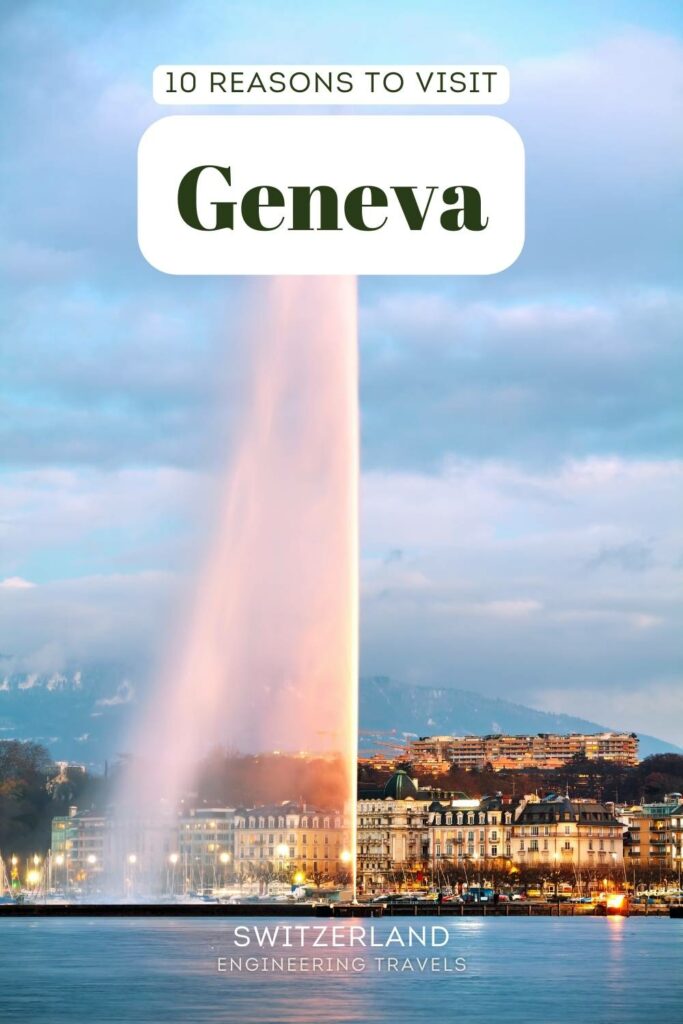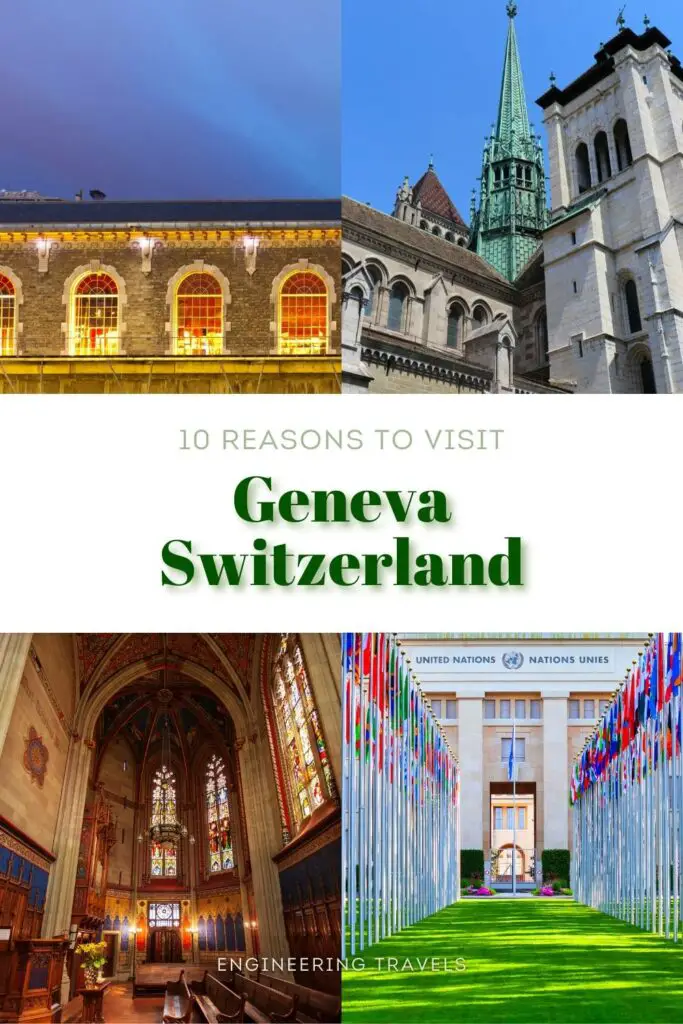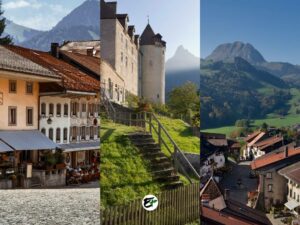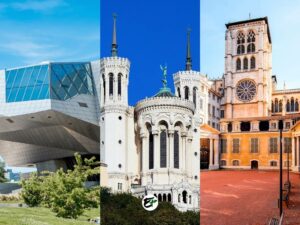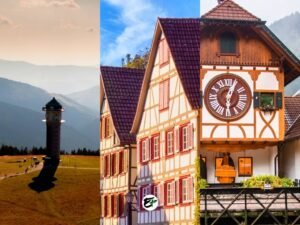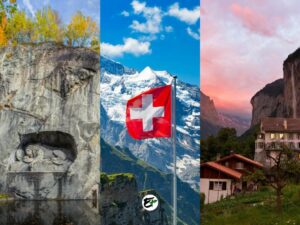Is Geneva Worth Visiting: A Guide to Its 10 Best Experiences
Wondering if Geneva, the second-largest city in Switzerland, is worth your time?
Known as the ‘Peace Capital’ of the world, Geneva is home to numerous international organizations, including the United Nations and the Red Cross, with a total of 39 international organizations based in the city.
Geneva is definitely worth a visit for its unique character shaped by these international organizations dedicated to human welfare and progress. You can learn so much from the museums of these organizations, not to mention the city’s historical attractions and beautiful architecture. And if you’re more into nature and adventure, Geneva could be your starting point.
Need more convincing?
I’ll be highlighting and guiding you to the 10 of the most captivating experiences or attractions in Geneva that make it an absolute must-see in this post. Some might argue that Geneva lacks excitement, but I’m confident these 10 reasons will change your mind.
This post contains affiliate links. I may receive a tiny commission at no additional cost to you.
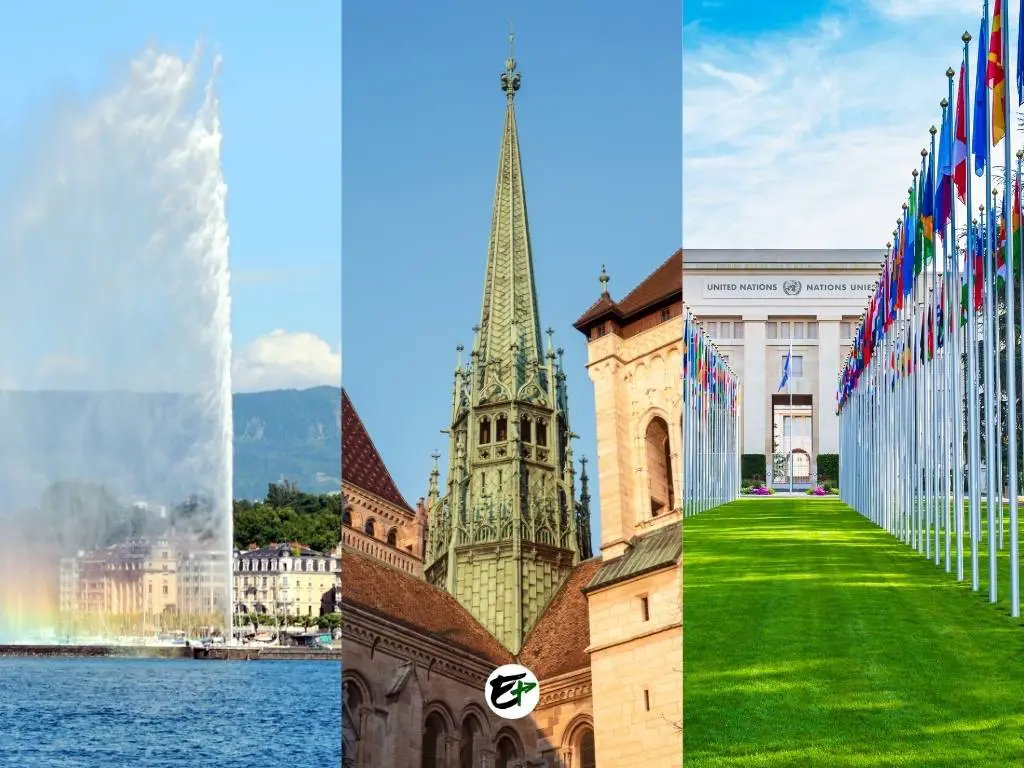
Use the table of contents to skip to topics.
If you take a look at the map, you’ll see that Geneva is nestled in the westernmost corner of Switzerland, almost entirely surrounded by France. Only a slender land ‘bridge’ on the northern shores of Lake Geneva connects it to the rest of Switzerland. Interestingly, Geneva is closer to the French Alps than the Swiss Alps if you’re traveling by road.
Not so interestingly, be prepared for a hefty price tag – Geneva is one of the most expensive cities in the world. For instance, meals for a day can set you back between 35 to 40 CHF (1 CHF = 1.1 USD). So, if you’re planning a trip to Geneva, don’t expect it to be budget-friendly.
Personally, I would strongly suggest heading straight for the Swiss Alps and bypassing the cities if it’s your first time in Switzerland. However, Swiss cities like Geneva do offer unique experiences that are worth considering, especially if you have the time and budget.
If the reasons I will share later will convince you to visit Geneva, you can use this link to find your ideal accommodation in the city. It will lead you to some of the best hotel deals available. Plus, there’s a handy map feature to help you locate hotels in the most convenient locations.
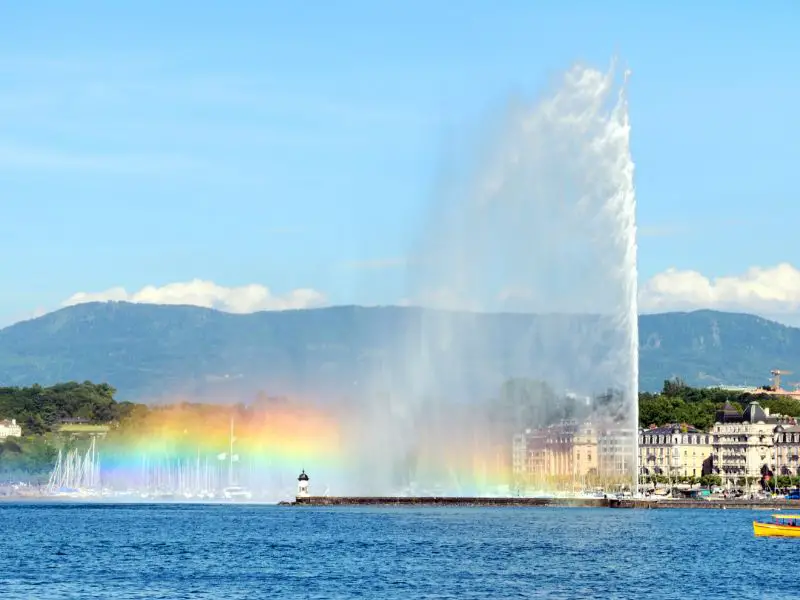
1. The Historical Old Town of Geneva
You might find this interesting — Geneva is known as Switzerland’s largest historical city. It’s not just because of its age, but because of its significance in human history. The Reformation movement left a significant mark on Geneva. Since then, it’s been called the ‘Protestant Rome.’
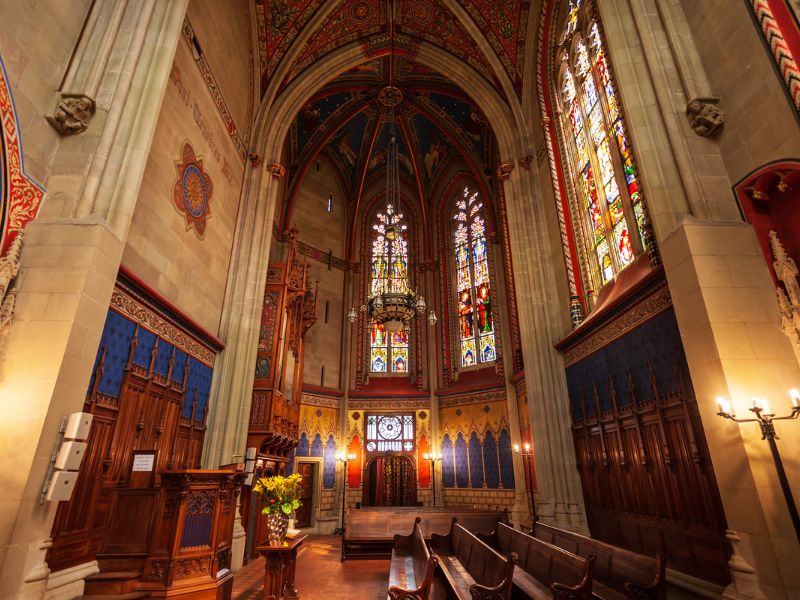

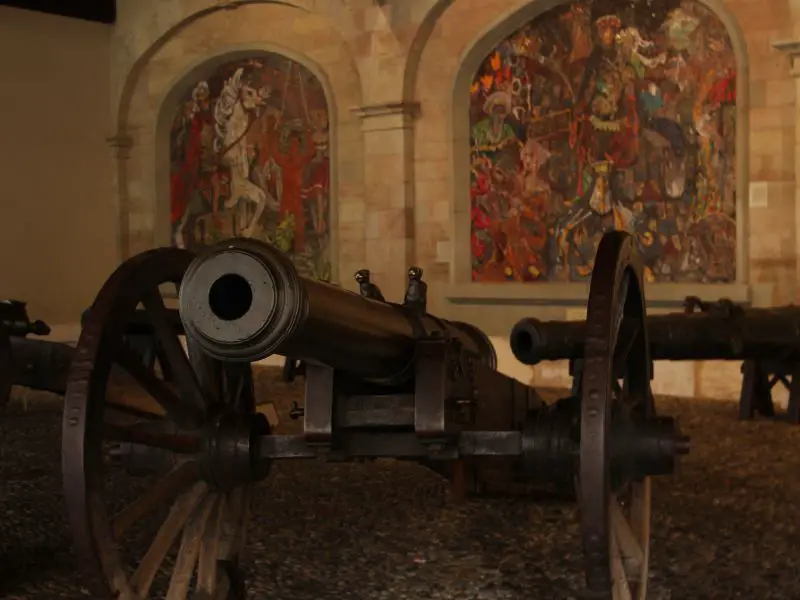
While Geneva’s reputation might be enough to pique your interest, there’s so much more to this city that makes it worth a visit.
Imagine wandering through its labyrinthine, charming, narrow streets, or taking in the breathtaking view from the tower of Saint Peter Cathedral. The nostalgic ambiance of Old Town Geneva is enough to stir the curiosity of any traveler.
And if you’re a history enthusiast? Old Town Geneva won’t disappoint. You can visit the 8-century-old Saint Peter’s Cathedral, check out the famous luxurious Hotel de Ville, or immerse yourself in Geneva’s extensive history at the Maison Travel Museum.
Traveling to Europe often involves admiring the stunning architecture and fascinating artworks of city churches – it might sound cliché, but hear me out. Each church is unique and offers something new to discover.
For example, Saint Peter’s Cathedral in Geneva isn’t just known for its mix of ancient and Gothic architectural design. It also houses an archaeological museum featuring mosaic paintings and parts of a 4th-century basilica that once occupied the same site.
But what really sets it apart is the Chapel of the Maccabees in the cathedral’s southwest wing. The chapel is simply breathtaking, particularly when sunlight streams through its stained glass windows. And be prepared for your jaw to drop at the sight of the chapel’s ornate ceiling, walls, and tympanum! The interior gives off a vibe that’s a mix of castle and church – it’s indescribable.
While these attractions are certainly highlights of a visit to Old Town Geneva, there’s so much more to discover. Just by meandering through the narrow lanes, you might stumble upon hidden gems like L’Ancien Arsenal, nestled next to the Maison Travel Museum.
This museum often catches travelers off guard, as it’s not typically mentioned in guidebooks. But once inside, you’ll find vibrant mosaics that depict various scenes from Geneva’s medieval period. The museum also showcases vintage cannons, some of which feature beautifully embossed designs.
The adventure of exploring Old Town Geneva doesn’t stop at its borders. Just a short walk to the south, and you’ll find yourself at Bastions Parc, home to the renowned Reformation Wall. And if you’re in the mood for some shopping, Rue du Marche, Old Town Geneva’s bustling shopping street, is just a few minutes away from the district’s center.
If you’re drawn to the allure of historical city centers, you might want to consider a few alternatives to Geneva. Nearby cities such as Bern, Annecy, Colmar, and Strasbourg are also steeped in history and are well worth a visit.
2. Unlock the Secrets of the Swiss Watch in Geneva
When it comes to creating exceptional train infrastructure and crafting exquisite watches, the Swiss are second to none. To see their impressive train infrastructure in action, head to the mountains – the Jungfrau region, to be precise. The Swiss trains operating there are truly a marvel.
But if it’s Swiss watches that pique your interest, then Geneva is the place to be. Exploring the rich history and advanced technology of watchmaking is a compelling reason to visit Geneva.
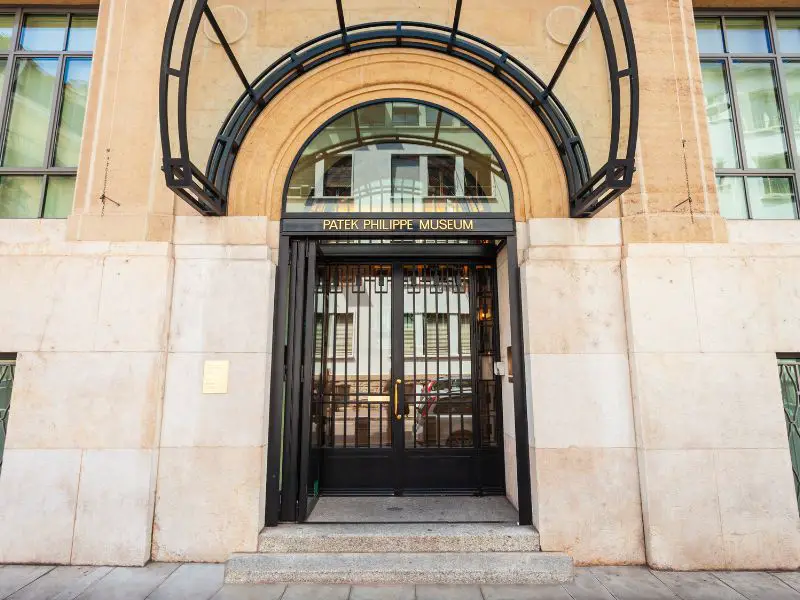
Did you know that the roots of the entire Swiss watchmaking industry can be traced back to Geneva? It’s quite impressive, considering it started as early as the 16th century
You might wonder how they managed to make watches work with the technology available at that time, especially considering electricity wasn’t discovered until 1752 and batteries weren’t invented until 1800.
If you’re intrigued by horology and watch design, I highly recommend a visit to the Patek Philippe Museum in Geneva. This museum offers a deep dive into the world of watchmaking, from its horological heritage to intricate techniques like engraving, guilloché work, enameling, and gem-setting.
With four floors of exhibits, an hour barely scratches the surface of all the dazzling watches on display. Despite its classic display cases, this museum is arguably one of the most spectacular horological museums in the world.
The watches on exhibit are truly one-of-a-kind and exude luxury. Just a heads up – photography isn’t allowed inside for security reasons, so you’ll have to see it for yourself! You can check the website of Patek Philippe to see sample exhibited items and learn the visitor’s information.
For a more insightful exploration of the museum, you might want to consider joining one of the guided tours. These tours are scheduled every Saturday at 2:00 pm and 2:30 pm. The earlier tour is conducted in French, while the latter is in English. Each tour provides a fascinating journey from the 16th century to the present day and lasts about two hours.
If you’re a traveler with a passion for museums, I can confidently say that you’ll adore exploring Paris and Florence. These cities house some of the most celebrated artworks globally! For more information, feel free to click on the city names.
3. CERN, Geneva’s Futuristic Scientific Research Center with an Impressive Science Museum.
If you’re involved in the fields of science and engineering (much like I was), you might have dreamt of visiting Geneva to see CERN and the Large Hadron Collider (LHC). In terms of the awe-inspiring nature of science, I’d say it’s Europe’s answer to NASA in the USA, and certainly a compelling reason to visit Geneva.
But what exactly are CERN and the LHC? Essentially, CERN, or Conseil Européen pour la Recherche Nucléaire, is a European research organization that operates the world’s largest particle physics laboratory, the Large Hadron Collider.
I first came across CERN and the LHC while watching a science documentary on YouTube, one of those videos that pop up just as you’re about to call it a night. The video sparked my curiosity about how humans could potentially create a miniature sun as a source of clean, unlimited energy.
It delved into how scientists at CERN are exploring nuclear fusion, the same process that powers our sun, as a means to achieve this. While the explanation was filled with scientific jargon best left to the experts, it was nonetheless fascinating.
And while CERN and the LHC are undoubtedly steeped in technology and science, you don’t have to be an expert to appreciate a visit to these research facilities. In my view, CERN is a must-visit destination, offering a glimpse into the remarkable progress humanity has made towards the future.
Another compelling reason to visit CERN in Geneva is the opportunity to grapple with the profound questions that CERN seeks to answer. Questions like, where did the universe originate? How does the universe behave? Does antimatter truly exist?
While you may not find definitive answers to all these questions, you’re guaranteed to learn a great deal during your visit. CERN houses two museums that you can explore either independently or as part of a guided tour. These are the Globe of Science and Innovation and the Microcosm.
One of the best parts? Admission is free. At CERN’s two museums, you’ll receive a comprehensive introduction to CERN and its various projects. While they do offer tours, they won’t take you to the actual collider – which is a whopping 17 kilometers long, by the way. However, if you’re really keen on seeing the LHC, you can follow this procedure from WikiHow.
On the first floor of the Globe of Science and Innovation, you’ll discover the Universe of Particles, CERN’s immersive interactive museum. Inside, you’ll be treated to videos about the Big Bang, complete with stunning visual effects that bring the birth of the universe to life. If you’re curious about how the LHC operates and what happens when particles collide, then a visit to the Microcosm Museum is a must.
For more information about CERN, its various exhibitions, and visitor details, you can check out CERN’s website.
If modern museums with interactive displays pique your interest, then Lyon’s Musée des Confluences, Munich’s BMW Museum, and Stuttgart’s Porsche and Mercedes Benz Museums are must-visit destinations. These museums are truly futuristic in their design and exhibits!
4. International Red Cross – Geneva and the World’s Most Inspiring and Striking Museum
Isn’t it fascinating how a visit to Geneva can take you on a journey through time? The city’s attractions offer more than just a glimpse into the medieval era – they transport you back to the very beginning of the universe, thanks to CERN. But did you know that Geneva can also provide a deeper understanding of current events?
I’m not talking about the often divisive and biased news we encounter daily. Rather, you’ll have the opportunity to immerse yourself virtually in significant events from human history and witness some of humanity’s most admirable achievements.
The International Museum of the Red Cross and Red Crescent (MICR) offers a wealth of beautiful, touching, and enlightening experiences. It could very well be the most meaningful reason to visit Geneva. The MICR showcases a truly unique museography.
More than just a repository of knowledge, history, and expressive artworks, the museum also aims to evoke emotions. It’s an inspiring and moving place that adds a deeper layer of significance to your visit to Geneva.
The MICR presents various issues affecting humanity in a thoughtful manner. You’ll encounter numerous stories from political prisoners, prisoners of war, and survivors of natural disasters and genocide. Interactive boards allow you to hear their stories and learn about the Red Cross’s efforts to improve their situations.
The International Museum of the Red Cross and Red Crescent (MICR) leverages technology to bring its exhibits to life in a truly spectacular way. Two standout examples are the dramatic scene in the Chamber of Witnesses and the room filled with holographs. The narratives presented in these exhibits, enhanced by modern effects, leave a lasting impression on all who visit.
In my view, it’s an effective strategy for ensuring the organization’s message resonates with visitors. At its core, the permanent exhibition at the MICR aims to share the testimonies of various witnesses, underscore the importance of human dignity, mitigate the risks of natural disasters, and restore family connections.
If you’re planning a trip to Geneva and considering a visit to the MICR, you can find all the information you need – from entry requirements and opening hours to admission fees and guided tours – on the museum’s visitor information page.
5. More and More Museums in Geneva
The learning opportunities in Geneva extend far beyond the museums previously mentioned – there’s so much more to discover! If you’re a museum enthusiast, Geneva has plenty more to offer. With over 35 diverse museums (not including galleries), ranging from natural history and archaeology to contemporary art and marionettes, there’s something for everyone.
Even sports fans are catered for with the Olympic Museum. So, if you love immersing yourself in museums, Geneva should definitely be on your travel list.

In addition to the CERN, Maison Travel, International Museum of the Red Cross and Red Crescent, and Patek Philippe Museum (which we’ve already discussed), there are several other renowned museums located in Geneva that you might want to explore:
- International Museum of Reformation
- Modern Art Museum
- Carouge Museum
- Museum of the History of Science
- Olympic Museum
- Ariana Museum
- Barbier-Mueller Museum
- Marionette Museum
- Rath Museum
- Botanical Gardens and Conservatory
- Art and History museum
There’s a wealth of museums to explore in Geneva, but in my opinion, the following three are particularly intriguing.
If you’re traveling with children, they’re sure to be captivated by the life-sized models of various animals from around the world at the Natural History Museum. This museum boasts not only hundreds of stuffed animals but also some live ones, including a rare two-headed turtle named Janus.
For those with an interest in archaeology, the Barbier-Mueller Museum is a must-visit. It houses over 7000 items of primitive art collected by renowned Swiss collectors Josef Mueller and Jean-Paul Barbier. You’ll be able to admire the intricate designs of jars, statues, and masks from Africa, Oceania, and Asia.
Lastly, whether you’re traveling with kids or simply curious about the scientific practices of the 17th to 19th centuries, I recommend a visit to the Museum of the History of Science. It showcases tools used by early scientists in their study of the world and universe, spanning fields from astronomy and electricity to microscopy and meteorology. Don’t miss the sundials and astrolabes on display!
6. Irresistibly Instagrammable Spots in Geneva
If you’re planning a museum-hopping adventure in Geneva, you’re likely to encounter stunning architecture, scenic landscapes, and remarkable landmarks along the way. As you explore Geneva, you’ll discover that it’s not just a city, but a sophisticated, photogenic cosmopolitan hub.
If you’re a photography enthusiast, Geneva is sure to captivate you! As a meeting point for international communities, a preserver of cultural heritage, and a city that’s constantly evolving toward the future, Geneva offers a diverse array of subjects and scenes for your photography.
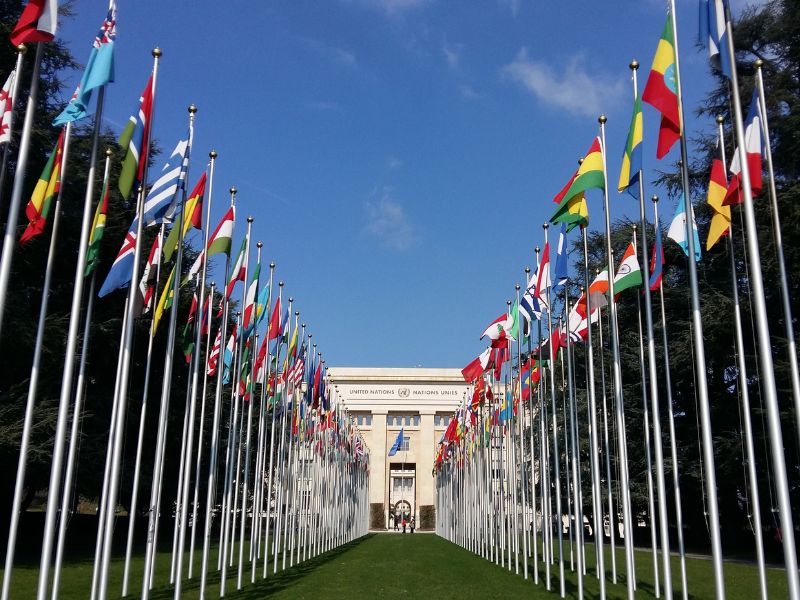
The influences of other nations can be seen in the cityscape of Geneva. Take mesmerizing photos of the city’s elegant buildings and capture the stunning appearances of its futuristic structures. Here is a list of the most picturesque spots in Geneva that you simply must visit:
- Schtroumph Buildings – A colorful set of buildings with odd shapes and curves. They are the houses behind the railway station straight out of a movie! See what they look like and where they are on Google Maps.
- Bâtiment des Forces Motrices – Perhaps one of the most picturesque buildings in Geneva in terms of exterior appearance. It is situated along the Rhone river, reflecting its array of windows. That’s the scene you must capture from this location.
- St. Pierre Cathedral – The photos of the facade of this church that looks like a Greek temple, its spire, the colorful stained glass mosaic, and the chapel inside shall fill up your camera’s storage real quick! I’ll pinpoint its location from this link.
- Ariana Museum is an elegant museum you’ll love to photograph, from its neoclassical appearance outside to the symmetric arches and columns inside. Don’t miss capturing the main building with its lovely fountain! Check its appearance from Google Maps.
- Hans-Wilsdorf Bridge – It’s a modern bridge composed of interlaced elliptic rings and linear elements. If you have an Instagram page featuring beautiful architectural works, a photo of this bridge can be included in your collections. It is right here in these coordinates.
- The Ferris Wheel (Swiss Wheel) – Have a romantic photoshoot while on the Swiss Wheel. Glamorous city lights are in the background. Its exact location is right here.
- United Nations Headquarters – Have an epic shot of yourself in the middle of the symmetric, long array of flags in front of the simply stunning Palais des Nations or UN Headquarters Geneva. It has a fountain that reflects The Celestial Sphere on it, with Palais des Nations in the backdrop. Here are the Google Maps coordinates.
- Viaduc de la Jonction – Behold and capture the spectacular joining of Arve and Rhone Rivers. In good weather, the colors of the two rivers don’t mix right away! Check the view from Google Maps.
- Carouge – A charming district with colorful streets similar to Italian towns. Colorful umbrellas (sometimes flags) are hung above its streets, like in Rue Saint Joseph. It’s a view you won’t resist posting on your Instagram!
- Jet D’eau Fountain – is the iconic fountain of Geneva (also one of the world’s tallest). It’s beautiful day and night. See it glow with different colors at night or watch it create a rainbow when sunlight hits it. See its superb appearance here.
Here are their photos for your inspiration:



If you’re on the hunt for truly picturesque destinations, your search might just come to a halt with my post about the most beautiful villages in the south of France. These villages offer more than just charm – they’re steeped in history and offer breathtaking scenery. Be sure to check it out! 😉
7. The Wines in Geneva
I may not be a wine enthusiast myself, but if you are, Geneva offers another compelling reason for a visit. Did you know that Geneva is not just one of the top wine-producing cantons in Switzerland, but its winemakers have also been recognized in many international wine competitions?
As per my last check, they had made significant strides with classic grape varieties such as Chardonnay. In Geneva, you can expect to find wines that deliver both in terms of quality and volume. One factor contributing to this is its geographical location, which is perfect for grape growing.
Nestled near the Jura mountains, Geneva and the nearby regions enjoy favorable microclimates that aid in the cultivation of vineyards.

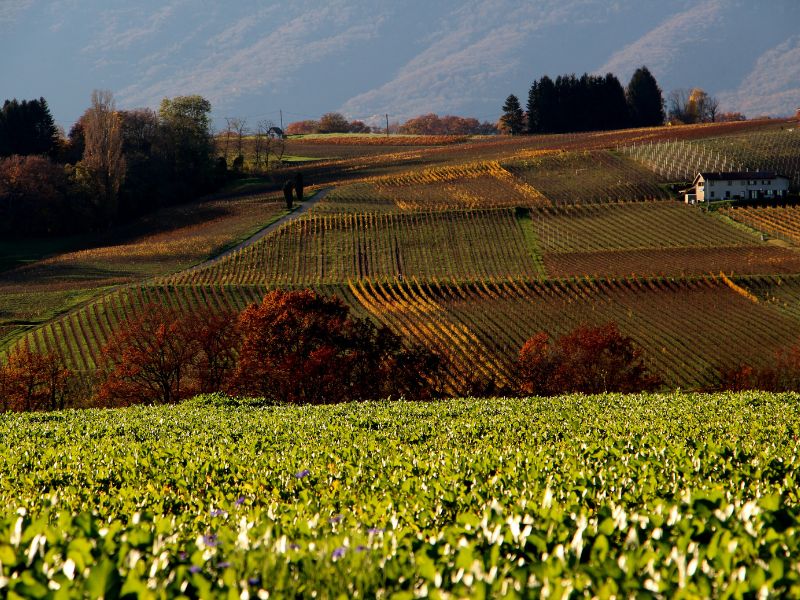
The nutrient-rich waters of the Rhone and Arve rivers, flowing down from the Alps, serve as natural supplements to Geneva’s vineyards. These waters deposit alluvial and moraine sediments that help keep the vines healthy and abundant with fruit grapes.
Another factor contributing to the exceptional taste of Geneva’s wines is the region’s long-standing tradition of winemaking, which dates back to the 12th century. This is when locals established the Lavaux Vineyard on the shores of Lake Geneva. If you venture to the outskirts of Geneva, you’ll be greeted by expansive vineyards that blanket the rolling landscapes like a lush green carpet, turning golden in certain seasons.
In the vicinity of Geneva, the application of cutting-edge viticulture techniques is prevalent. For those visiting Geneva, the local wines can be savored in three distinct manners – embarking on a journey to the wine-producing villages of Geneva, indulging in wine shopping, and pairing meals with exquisite wines.
Here are some suggested activities centered around these wines:
- Take a hike in the area known as Rive Droite, situated on the right bank of the Rhone River. This 26-kilometer, 6-hour trek traverses through Satigny (Geneva’s largest winegrowing village), Meyrin, Dardagny, Celigny, and Collex-Bossy. The hiking trail is adorned with idyllic Swiss countryside scenery that laid-back adventurers will surely love! Route information can be found [here].
- Experience wine tasting at Mövenpick Wines in Meyrin where you can sample an array of wines at your leisure – there’s no time limit and no pressure to buy. Mövenpick Wines boasts a wide selection of wines from various types of red to white. The amiable staff can provide comprehensive descriptions of each wine to help you decide which wines to purchase. Check their [website] for visiting information, events, etc.
- Finally, enjoy a meal at Le Rouge et le Blanc restaurant. This restaurant is perhaps one of the most romantic places in Geneva, offering stunning views of Lake Geneva, including Jet d’Eau, and the Jura Mountains. Enjoy these views while dining on international cuisine paired with a fantastic selection of local wines listed on their menu. Check out the atmosphere and menu from the [restaurant’s website] or [Instagram].
If your travels are guided by your love for wine, Geneva is likely on your radar. But before you finalize your plans for Geneva, take a moment to explore Reims. As a central location in the UNESCO Champagne region, Reims might provide a more captivating experience for you. Wurzburg is another destination worth considering. Known for its stunning Rococo buildings and fine wines, Wurzburg is part of Franconia – a region in southern Germany that’s famed for its wines.
8. Geneva’s Panoramic Views of Lake and Mountains
What draws me to Geneva as a place to explore? It’s a city where one can find unique urban experiences, including advanced museums, engaging exhibitions, and stunning medieval architecture. But there’s also the charm of the countryside and nature!
Geneva, as a canton, is home to vineyards and its own lake. Although the mountains are located across the French border, they are easily accessible from the city. The beauty of these places is reason enough to plan a trip to Geneva.

Indeed, the vistas may not rival those of the Alps, but there are few European metropolises where such panoramas can be witnessed within the city limits. In Switzerland, Zurich, the nation’s largest city, shares a similar geography with Geneva.
The delightful views of lakes and mountains begin at Geneva’s charming Jardin Anglais and extend to the tranquil countryside of the wine villages mentioned earlier. For me, however, Mont Salève stands as the ultimate awe-inspiring spot easily accessible from Geneva – I’ll explain why later.
You don’t need to hike or travel far from the city to enjoy panoramic sights. Scenic views await you right in Old Town Geneva at the top of Saint Peter’s Cathedral’s tower. The journey to the top involves climbing a 157-step staircase, but don’t let that deter you! The effort is rewarded with 360-degree views of the entire city, surrounding mountains, and lakes.
If you’re planning to extend your stay in Geneva beyond a day, consider adding Mont Salève in France to your itinerary. Despite being located in France, it’s conveniently accessible from Geneva with just one bus ride (bus #8 heading to the French border or Veyrier) and one cable car ride. See the exact location [here].
Mont Salève is the nearest mountain to Geneva, with its peak reaching 1379 meters above sea level. From this vantage point, you can enjoy a panoramic view of the entire city of Geneva. The colossal Jet d’Eau will appear as a mere sprout from this height!
A day trip to Mont Salève from Geneva opens up opportunities for adventures akin to those in other parts of the Alps. Activities such as hiking, mountain biking, paragliding, and cross-country skiing in winter are available. It serves as an excellent alternative if you’re short on time to explore the Swiss or French Alps.
9. Beautiful Day Trips in the Picturesque Lake Geneva
Earlier, I touched upon various day trips that one can embark on from Geneva, which include exploring vineyards and hiking up a mountain. However, it’s crucial to highlight its lake, which houses two of Switzerland’s most enchanting attractions: the Lavaux Vineyard and the Chillon Castle.
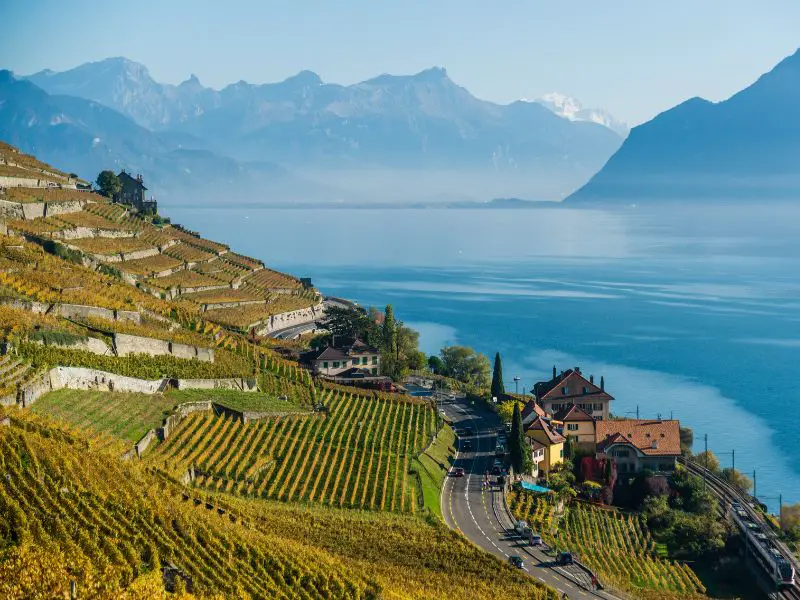
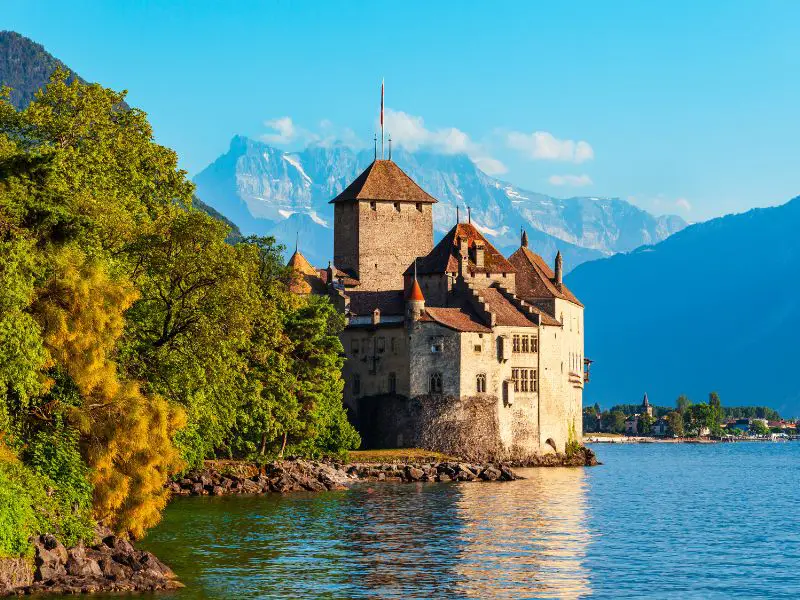
One can opt for either a train ride or a cruise from Geneva to the Lavaux Vineyard and Chillon Castle. Trains offer a quicker mode of travel, making them an ideal choice if you’re pressed for time. As a bonus, the train journey takes you through an area adorned with spectacular terraced vineyards, their lush or golden hues varying with the seasons.
Alternatively, a cruise offers a leisurely journey with almost endless stunning views of the lake. Lake Geneva, with its crescent shape nestled against the French Alps to the south, often presents serene and misty vistas where snowy peaks seamlessly transition into a smooth, wavy lake.
Departing from Geneva, the first destination you’ll encounter is the Lavaux Vineyard. So, what exactly is the Lavaux Vineyard? It’s a terraced vineyard that has held the status of a UNESCO heritage site since 2007. This remarkable 30-kilometer-long, 830-hectare viticultural haven boasts hiking trails, wine shops, restaurants, and breathtaking views, making it an ideal spot for a romantic nature retreat easily accessible from Geneva.
While the Lavaux Vineyard is indeed a beautiful destination, Chillon Castle garners more attention due to its timeless allure and exceptional location. As an island castle located on the eastern coast of Lake Geneva, it offers a unique perspective.
The grandeur of the French Alps, the tranquility of Lake Geneva, and the medieval charm of Chillon Castle converge to provide a fairytale-like experience that will leave a lasting impression! But there’s more than just the view – the castle houses exhibits of artifacts and historical objects that offer insight into the region’s history.
After visiting Chillon Castle, you can return to Geneva or make a pit stop in Montreux, Switzerland’s city of music. The legendary band Queen has a dedicated museum in the city – a must-visit for any fan!
If you’re drawn to lakes that are graced with the presence of castles on their shores, then Lake Thun, which can be viewed from Interlaken or Thun, along with Lake Como and Lake Garda in northern Italy, are destinations you should consider visiting.
10. The Gateway to the Swiss and French Alps
While Geneva may not boast the most breathtaking views in Switzerland, it serves as an ideal starting point for exploring the rest of the country. Its proximity to Annecy (here are the reasons to visit Annecy) and Chamonix (here are reasons to visit Chamonix) makes it a prime location for commencing trips to the French Alps.
After immersing yourself in the city’s rich array of museums and attractions, which are the primary reasons to visit Geneva, you can easily venture to more awe-inspiring locations in France and Switzerland. The convenience that Geneva offers to travelers is a compelling reason to choose this city as your base.
Here are some of the day trips you can have from Geneva:
Have a look at this table to see how quickly you can get to more beautiful attractions in the region:
| Next Destination | Road Distance (km) |
Travel Time (private car) |
Public Transportation | Travel Time (public transportation) |
|---|---|---|---|---|
| Laussane | 63.3 | 54m | 1 train ride | 48m |
| Montreux | 93.3 | 1h 12m | 1 train ride | 1h 11m |
| Gruyeres | 120 | 1h 25m | 2 train, 1 bus rides | 2h 30m |
| Annecy | 40.8 | 31m | 1 train ride | 1h |
| Chamonix | 81.8 | 56m | 1 bus ride | 1h 10m |
You can find the best hotel deals in Geneva here.
If you’re seeking ideas for your next destination in Switzerland, I have plenty of suggestions. For a quick overview, you can refer to my 14-day Switzerland Itinerary.
Gruyeres is another destination near Geneva that you might find interesting. It is a well-preserved medieval village located in the Prealps. Come and taste the authentic Gruyeres Cheese and indulge in unlimited chocolates!
For other notable attractions in Switzerland (complete list: Beautiful Villages in the Swiss Alps), consider the following:
- Jungfrau Region: A top destination in the Swiss Alps offering adventures, scenic train rides, and remarkable mountaintop attractions. Check out Interlaken (with beautiful lake attractions), Lauterbrunnen (a heavenly valley with rustic villages), and Grindelwald (the best destination for outdoor activities and adrenaline-pumping adventures).
- Kandersteg: A charming village closest to Oeschinensee, one of the most beautiful lakes in Switzerland.
- Zermatt: An alpine village/ski resort/hiking destination where you can see the famous Matterhorn mountain.
You might also want to explore cities near the Swiss Alps. These cities are close to the best tourist attractions in the Swiss Alps and can serve as an alternative base for exploring Switzerland’s major cities.
- Sion: The capital of the canton of Valais with a hilltop church and chapel.
- Thun: A picturesque city home to the oldest panorama painting and several castles.
- Brig: The gateway city to Italy, known for the Stockalper Palace and the scenic Simplon Pass.
- Lucerne: A charming city with remarkable landmarks (Chapel Bridge and Lion Monument) and proximity to Mount Rigi and Mount Pilatus.
Best Time to Visit Geneva
Geneva is a wonderful city that you can visit anytime of the year, but some seasons may suit your travel plans better than others.
Here are some tips on when to go to Geneva based on what you want to see and do.
Firstly, if you are keen on exploring the city center of Geneva and its landmarks and museums, you can do so anytime of the year. However, some seasons may offer more benefits than others. Spring and autumn are great times to visit Geneva because of the mild weather and lower prices.
Summer is also a good time to visit Geneva because of its lively atmosphere and festive mood. There are many events and festivals that take place in Geneva during summer, such as the:
- Fête de la Musique where you can enjoy free concerts of various genres all over the city, the Lake Parade where you can dance to techno music on boats along the lake shore
- National Day where you can celebrate Switzerland’s birthday with fireworks and bonfires on August 1st
- and Fêtes de Genève where you can have fun with concerts, fireworks, carnival rides, food stalls, and more for 10 days in August.
Winter is not a bad time to visit Geneva either if you don’t mind the cold weather and shorter days. You can still enjoy some indoor activities in the city center or take a day trip to nearby ski resorts
You can also experience some of Geneva’s winter traditions and celebrations, such as
- Supercross Geneva where you can watch motocross riders perform stunts and tricks,
- La Coupe de Noël where you can join or watch a swimming race in the freezing lake,
- Fête de l’ Escalade where you can reenact Geneva’s victory over Savoy with costumes and chocolate pots,
- Geneva International Motor Show where you can see the latest cars and innovations, artgenève where you can discover contemporary art from around the world, and more.
If you love wine and nature, you should go to Geneva in late summer or early autumn. This is when the Lavaux Vineyard’s vineyards are a sight to behold, especially when the grapes are ready for harvest and the leaves turn yellow and orange. You can also taste some of the finest wines in Switzerland or join a guided hike through the vineyard terraces.
And if you are into history and culture, you can go to Geneva anytime of the year and visit the Chillon Castle, one of the most visited castles in Europe. The castle is open every day except on Christmas Day and New Year’s Day, and it offers a glimpse into the medieval life of the Savoy dynasty.
You can explore the castle’s rooms, dungeons, courtyards, and gardens, or join one of the many events that take place there throughout the year, such as medieval festivals, concerts, exhibitions, and workshops.
If you are looking for some adventure and fun in the mountains, you have two options: winter or summer.
Winter is the perfect time for snow lovers who want to ski, snowboard, sled, ice skate, or enjoy other snow sports in the French and Swiss Alps. There are many ski resorts near Geneva that cater to all levels of skiers and snowboarders, such as Chamonix, Verbier, Zermatt, and Les Portes du Soleil.
However, winter is also the most expensive and crowded season, so make sure you book your accommodation and transportation well in advance. You should also be prepared for cold weather and possible snowstorms.
Summer is the ideal time for hikers, bikers, paragliders, rafters, or anyone who wants to enjoy the outdoors in the Alps. The weather is warm and sunny, the flowers are blooming, and the views are stunning. You can choose from many trails and paths that crisscross the mountains, or take a cable car or a train to reach higher altitudes. You may still find some deals on accommodation and transportation if you book early.
If you want to relax and have fun in Lake Geneva, you can do so anytime of the year. However, the best time to enjoy the lake is in summer, when the water is warm enough for swimming. You can also rent a boat or a kayak, or join a cruise or a ferry ride to see the lake from different angles.
The Bains des Pâquis public baths where you can swim or sunbathe with locals, and the Île Rousseau island park where you can relax or have a picnic.
How to Get to Geneva
There are different ways to reach Geneva depending on where you are coming from and what mode of transportation you prefer.
By Air
The closest airports to Geneva are Geneva International Airport (GVA) and Annecy – Haute-Savoie – Mont Blanc Airport (NCY). GVA is only 4 km away from the city center, while NCY is about 30 km away.
From GVA to Geneva City Center
If you fly to GVA, you have several options to get to the city center:
- Train: This is the fastest and easiest option. You can take a train from the airport to the main station (Gare Cornavin) in just 7 minutes. The trains run every 15 minutes and you can get a free ticket for public transport in the baggage claim area.
- Bus: This is another convenient option. You can take a bus from the airport to various destinations in the city center. The buses run every 10 to 15 minutes and you can also use the free ticket for public transport. The bus lines that serve the airport are 5, 10, 23, and 28.
- Taxi or Uber: This is a more expensive option. You can take a taxi or an Uber from the airport to the city center. The journey time is about 10 minutes.
From NCY to Geneva City Center
If you fly to NCY, you have fewer options to get to the city center:
- Bus and Train: This is the cheapest option. You can take a bus from the airport to Annecy train station, and then take a train to Geneva. The bus journey takes about 15 minutes while the train journey takes about an hour.
- Taxi or Uber: This is a more costly option. You can take a taxi or an Uber from the airport to Geneva. The journey time is about 40 minutes.
By Train
If you are coming from another city in Switzerland or France, you can take a train to Geneva. The trains run frequently and offer scenic views of the countryside and Lake Geneva.
From Zurich, Basel, or Bern
You can take a train from Zurich, Basel, or Bern to Geneva. The journey time is about 3 hours from Zurich, 2 hours and 40 minutes from Basel, and 2 hours from Bern.
From Paris, Lyon, or Marseille
You can take a train from Paris, Lyon, or Marseille to Geneva. The journey time is about 3 hours from Paris, an hour and a half from Lyon, and 4 hours from Marseille.
How Many Days in Geneva
Geneva is a nice place to visit, even if you only have a day. You can see the landmarks that make it famous, wander around the Old Town and learn about its past, and discover something new in one of its museums.
You can start by seeing the Jet d’Eau. Then, you can walk to the Old Town, where you can see the St. Peter’s Cathedral, the Reformation Wall, and the lovely old streets.
After that, you can hop on a bus or a tram to the Palais des Nations, where the United Nations works in Europe. You can take a tour to learn more about its history and mission.
Alternatively, you can visit the International Red Cross and Red Crescent Museum, where you can find out more about their humanitarian work.
If you have some extra time, you can also take a boat ride on Lake Geneva or walk along the lakefront to watch the sunset.
With three days in Geneva, you can discover more of its culture and nature. Besides the highlights we mentioned before, you can also check out some of its amazing museums and nearby natural attractions. For instance, for your second day in Geneva:
- you can see the biggest collection of watches in the world at the Patek Philippe Museum
- or admire the paintings of Van Gogh, Monet, Picasso, and more at the Museum of Art and History.
- You can also find out more about the evolution of life on Earth at the Museum of Natural History,
- or enjoy the beauty of ceramics and glass at the Ariana Museum.
Lastly, you can also go on a day trip (3rd day) to Chillon Castle, Lavaux Vineyard, or some other place in the Swiss or French Alps.
Where to Stay in Geneva
Are you planning to visit Geneva, Switzerland? If so, you might be wondering where to stay in this beautiful and cosmopolitan city. Geneva has a lot of options for accommodation, ranging from luxury to budget, and from historical to modern.
Depending on your preferences and needs, you can choose one of the following areas to book your hotel:
- Old Town — is a great area to stay if you want to be close to many of the city’s attractions, but be prepared to pay a high price for it. Old Town can also be noisy and crowded, especially during peak seasons.
- Paquis — This is where you can find the most diverse and lively nightlife in the city, with many bars, clubs, restaurants, and ethnic shops. Paquis is also close to the main train station, the lakefront, and the iconic Jet d’Eau fountain. Paquis is a great area to stay if you want to enjoy the city’s vibrancy and multiculturalism, but be aware that it can also be noisy, dirty, and unsafe at night, as it is known as the red-light district of Geneva.
- Eaux Vives — is the area to stay if you want to have some peace and elegance in Geneva. This is where you can enjoy the stunning views of Lake Geneva and the surrounding mountains. You can also relax in some of the city’s most beautiful parks, such as Parc La Grange and Parc des Eaux-Vives. Eaux Vives is a great area to stay if you want to have a comfortable and relaxing experience, but be ready to pay a premium price for it. Eaux Vives can also be remote and boring, especially at night.
- Quai du Mont-Blanc — is the most convenient area in Geneva when it comes to transportation, restaurants, and attractions. This is the lakefront area that offers breathtaking views of the Jet d’Eau fountain and the Alps. It is also close to the main train station, the bus terminal, and the boat dock that can take you to other parts of the lake. You can find many restaurants, bars, and shops along the promenade that cater to different tastes and budgets.
Here’s where you can find the best hotel deals in Geneva.
How to Get Around Geneva
One of the best things about Geneva is that you can get around the city and its surroundings easily and conveniently by using public transport.
Geneva has a great public transport system that includes buses, trams, trolleybuses, and trains. A single ticket costs CHF 3.00 (2023) and is valid for 60 minutes. You can also buy day passes or multi-day passes for unlimited travel within the city.
You can use the same ticket for all of them within the city and its suburbs. You can buy tickets from machines at the stops or online. Most of the attractions and landmarks in Geneva are within 15 to 30 minutes by bus or tram from the main train station (Gare Cornavin). For example, you can take bus 8 to the United Nations (Palais des Nations), tram 14 to the Old Town (Vieille Ville), or tram 15 to the International Red Cross and Red Crescent Museum.
You don’t need to rent a car unless you want to explore some remote areas that are not well connected by train or bus.
If you stay at a hotel, hostel, or campsite in Geneva, you will get a free Geneva Transport Card that lets you use public transport for free during your stay. You can also use this card to get discounts on some attractions and activities in the city.
If you want to visit some places outside Geneva, you can also take a train or a boat from the city. For instance, you can go to Lavaux Vineyard, which is about an hour away by train. You can take a train from Genève to Vevey or Montreux and then change to a local train that stops at various villages along the vineyards. You can also take a boat from Geneva to Vevey or Montreux and enjoy the scenic views of the lake and the mountains.
Another place that you can visit by train or boat is Chillon Castle, which is located on the eastern shore of Lake Geneva, near Montreux. You can take a train from Genève to Veytaux-Chillon in about an hour and 15 minutes, or a boat from Geneva to Chillon Castle in about two hours. The castle is a short walk from the train station or the boat dock.
You can also explore Lake Geneva by taking a boat cruise from Geneva to various destinations along the lake, such as Lausanne, Evian, Yvoire, Nyon, Morges, and more.
Renting a car in Geneva might be useful if you want to explore other regions of Switzerland or France that are not easily accessible by public transport. However, driving in Geneva can be stressful due to traffic congestion, limited parking spaces, and high parking fees. You also need to pay for a motorway sticker (vignette) if you want to use the highways in Switzerland. The vignette costs CHF 40 (2023) and is valid for one year.
Save it on Pinterest.
